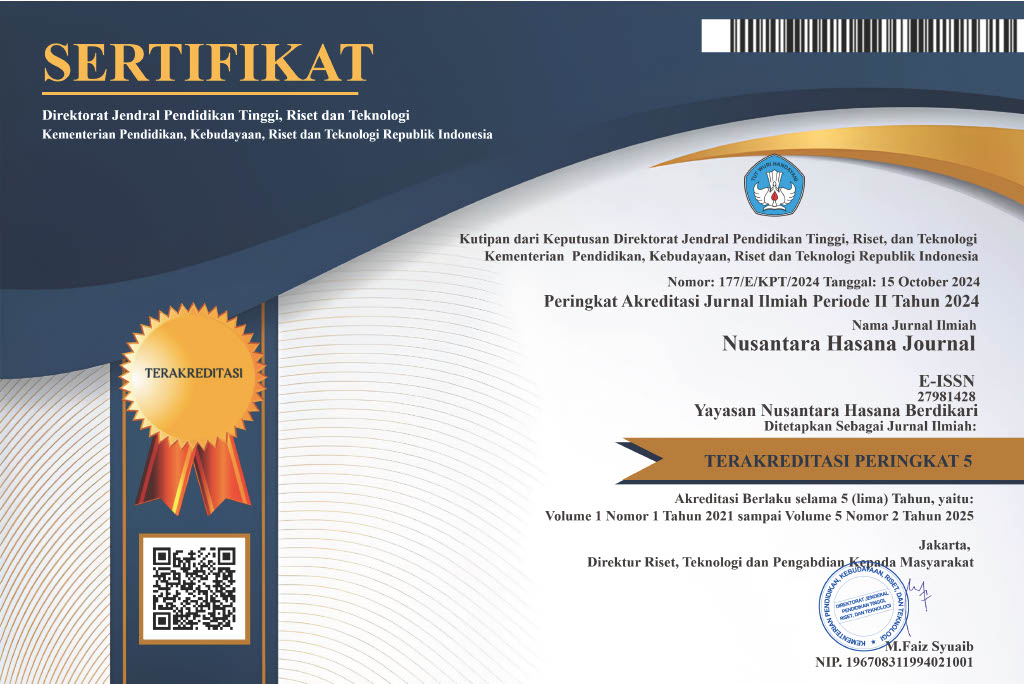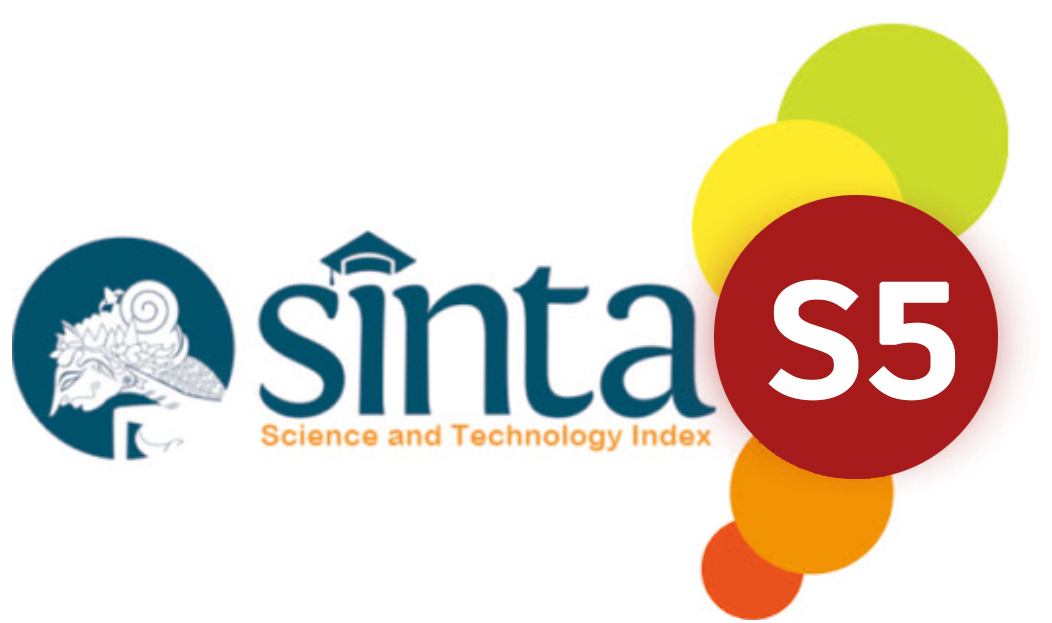KAITAN ANTARA TINGKAT PENGETAHUAN IBU DAN TINGKAT KEKAMBUHAN EPILEPSI DENGAN KUALITAS HIDUP PASIEN EPILEPSI ANAK DI RUMAH SAKIT UMUM DAERAH DOMPU
DOI:
https://doi.org/10.59003/nhj.v4i12.1502Keywords:
Dompu, Child Patients, DiseasesAbstract
Epilepsy contributes to a significant burden of disease in children and adolescents worldwide. The study aims to determine the relationship between maternal knowledge, duration of suffering and epilepsy recurrence rate with the quality of life of pediatric epilepsy patients at Dompu Regional General Hospital. This study is an observational analytical study with a cross-sectional study design. This study was conducted in August 2024 at Dompu District Hospital, West Nusa Tenggara Province. There is a significant relationship between maternal knowledge and epilepsy recurrence rate on the quality of life of pediatric epilepsy patients at Dompu Regional General Hospital. There is a significant relationship between maternal knowledge and epilepsy recurrence rate on the quality of life of epilepsy patients at Dompu Regional General Hospital which is indicated by a p-value of 0.011 (p-value <0.05) and a correlation coefficient of 0.370, which indicates that the higher the mother's knowledge, the better the child's quality of life. There is a significant relationship between the rate of epilepsy recurrence and the quality of life of epilepsy patients at Dompu Regional General Hospital, which is indicated by a p-value of 0.019 (p-value <0.05) and a correlation coefficient of -0.344, which indicates that the more frequent the recurrence occurs, the lower the patient's quality of life.Downloads
References
Almeida, C. de, Miccoli, L. S., Andhini, N. F., Aranha., Bachman,L., Chick, K., Chick., Askey, D., & J, R. (2016). Metode Penelitian Etnografi.
Altwaijri, W. A., Yahya, B. J., Alasmari, L. B., Alsultan, R. N., Alsuhaibani, S. M., Alsemih, R. M., & Moukaddem, A. K. (2020). Quality of life in pediatric patients with intractable epilepsi at a large pediatric university hospital in Riyadh, Saudi Arabia. Family Medicine & Primary Care, 9(11), 5523–5536.
Brown, L., & Joe, T. (2020). Psychosocial effects of long-term epilepsy. Epilepsy & Behavior, 102, 205-212.
Carpentier, Jonas, J., Frismand, S., Vignal, J., Rikir, J., & Baumann, C. (2013). Direct evidence of nonadherence to antiepileptic medication in refractory focal epilepsi.
Catherine Aranda, M., & Spence, S. J. (2013). Best Practices: Anakcs. In Autism Spectrum Disorders.
Collins, A., &Quillian, M. R. (2023). The structure and function of knowledge. Cognitive Psychology, 143, 103457.
Duarsa, A. B., Arjita, D., Ma’ruf, F., Mardiah, A., Fachrudi, Budiarto, J., & Utami, S. (2021). Buku Ajar Penelitian Kesehatan (1st ed.).
Duncan, J. S., Sander, J. W., & Sisodiya, S. M. (2023). Quality of life in children with epilepsi: New insights and management strategies. The Lancet Neurology, 22(4), 274-283.
Fisher, R. S., Cross, J. H., D’Souza, C., French, J. A., Haut, S. R., Higurashi, N., Hirsch, E., Jansen, F. E., Lagae, L., Moshé, S. L., Peltola, J., Roulet Perez, E., Scheffer, I. E., Schulze-Bonhage, A., Somerville, E., Sperling, M., Yacubian, E. M., & Zuberi, S. M. (2019). Instruction manual for the ILAE 2017 operational classification of seizure types. Epilepsia, 58(4), 531–542.
Gholami, A., Salarilak, S., Lotfabadi, P., Kiani, F., Rajabi, A., Mansori, K., & Jahromi, Z. M. (2016). Quality of life in epileptic patients compared with healthy people. Medical Journal of the Islamic Republic of Iran, 30 (1).
Gibbs, J. H., & Lai, K. (2024). "Advanced Neuroimaging Techniques in Epilepsi: From Structural to Functional Imaging." Brain Imaging and Behavior.
Gordon, W. A., Hibbard, M. R., & McGlynn, S. (2023). Traumatic brain injury and post-traumatic epilepsi: A review. Neurotrauma Reports, 4(1), 45-56.
Gratia, M. P., Nur, F. T., & Riza, M. (2020). Pengaruh Pendapatan Orangtua terhadap Kualitas Hidup Pasien Epilepsi Anak. Sari Anak, 22(4), 230.
Hardiyanti, Paul Joae Brett Nito, N. H. (2020). Hubungan Pengetahuan Orang Tua Dengan Tingkat Kekambuhan Pada Anak Epilepsi: Literature Review. 2, 163714.
Helmstaedter, C., Elger, C. E., & Wyllie, E. (2022). Structural brain changes and epilepsi: From acute injury to long-term outcomes. Journal of Neurotrauma, 39(12), 2045-2057.
Herno, S., Hamid, M., Dian, W. A., & Rika, D. (2020). Kualitas Hidup Ditinjau Dari Tingkat Kecemasan Pasien Penderita Ulkus Diabetikum.
Kemenkes RI. (2017). Pedoman Nasional Pelayanan Kedokteran Tatalaksana Epilepsi Pada Anak. 4, 9–15.
Khansa, A. N., Dewi, D. R. L., & Ilmiawan, M. I. (2024). Hubungan Usia Onset dengan Fungsi Kognitif Pasien Epilepsi di RSUD dr. Soedarso Kota Pontianak, Indonesia.Faculty of Medicine, Tanjungpura University, Pontianak, Indonesia.
Krogh, M., Andersen, A., & Hansen, M. (2023). Parental knowledge and its impact on the management and quality of life of children with epilepsi. Epilepsi& Behavior, 130, 108508.
Kwon, M., & Rogers, J. (2023). The impact of epilepsy recurrence and duration on the quality of life in pediatric patients: A longitudinal study. Seizure: European Journal of Epilepsy, 75, 72-78.
Lado, F. A., & Moshé, S. L. (2023). "Electroencephalography in Epilepsi: Advances and Clinical Applications." Epilepsi Research.
Lee, A. Y., & Zhang, M. (2023). Seizure frequency and its correlation with health-related quality of life in epilepsi patients. Journal of Clinical Neuroscience, 95, 66-73.
Miller, L. M., & Hargrove, J. David. (2023). Impact of parental knowledge on the quality of life of children with epilepsi: A systematic review. Epilepsi & Behavior, 142, 108334.
Mizuguchi, M., Ito, S., & Yoshinari, H. (2023). Genetic mutations in Dravet syndrome: Clinical implications. Journal of Medical Genetics, 60(4), 287-295.
Mozapramitha, M. R., Thursina, C., & Sutarni, S. (2019). Hubungan Pengetahuan Orang Tua Terhadap Frekuensi Bangkitan Pasien Epilepsi Anak di RSUP Dr . Sardjito Yogyakarta Correlation Between Parent ’ s Knowledge Towards Frequecy Of Seizure In Children With EpilepsiIn RSUP Dr . Sardjito Yogyakarta.
Padmarini Gantari Sari, P. R., Sutriani Mahalini, D., Budi Hartawan, I. N., & Kanya Wati, D. (2023). Tingkat kualitas hidup pasien anak epilepsi dengan QOLCE-16. Intisari Sains Medis, 14 (3), 1249-1253.
Pinzon, R. T., Wijono, A. D., & Renita, R. D. L. (2020). Age-Related Factors of Epilepsiand Its Impact on Quality of Life : a Cross-Sectional Study in Bethesda Hospital Yogyakarta. Jmj, 8 (2), 121–126.
Rasyid, F. (2022). Metodologi penelitian: Kualitatif dan kuantitatif: Teori, metode, dan praktek (Cetakan I). IAIN Kediri Press. ISBN 978-623-7682-12-7.
Rumah Sakit Umum Daerah Provinsi Nusa Tenggara Barat. (2023). Laporan tahunan Rumah Sakit Umum Daerah Provinsi Nusa Tenggara Barat tahun 2022. Rumah Sakit Umum Daerah Provinsi Nusa Tenggara Barat.
Sander, J. W., & Shorvon, S. D. (2023). The epidemiology of epilepsi: A global overview. Journal of Neurology, Neurosurgery & Psychiatry, 94(5), 631-637.
Sari, T. E. (2021). Faktor-Faktor Yang Mempengaruhi Quality of Life Pasien Epilepsi Yang Kontrol Ke Poliklinik Anak M Djamil Padang. Human Care Journal, 6(2), 320.
Singh, G., & Sander, J. W. (2020). The global burden of epilepsi report: Implications for low- and middle-income countries. Epilepsi & Behavior, 105, 106949.
Sinha, S. (2020). The impact of epilepsy duration on quality of life: A review. Epilepsy Research, 162, 106249.
Smith, M. L., & Jones, R. K. (2024). Comprehensive management approaches in pediatric epilepsi: The role of psychoeducation and family counseling. Journal of Pediatric Neurology, 42(1), 19-30.
Sugiyono. (2015). Statistika Untuk Penelitian Kesehatan.
Szaflarski, M., Meckler, J. M., Privitera, M. D., & Szaflarski, J. P.(2018). Quality of life in medication-resistant epilepsy: The effects of patient’s age, age at seizure onset, and disease duration. Epilepsy & Behavior, 8(4), 547–551.
Tellez-Zenteno, J. F., Hernández-Ronquillo, L., & Wiebe, S. (2022). Access to epilepsicare and its impact on quality of life: A review. Seizure, 92, 67-73.
Thomas, M., Badyal, D. K., & Pandian, J. D. (2023). Comparing the quality of life of patients with epilepsy receiving conventional and newer antiepileptics in a tertiary care hospital, Northern India. Department of Pharmacology, Teerthanker Mahaveer Medical College and Research Centre, Moradabad, Uttar Pradesh, India.
Widjaja, E., Puka, K., Speechley, K. N., et al. (2023). Trajectory of health-related quality of life after pediatric epilepsy surgery. JAMA Network Open, 6(3), e232737.
Wishwadewa WN, I, M., M, S., A, F., Soedjatmiko, &B, T. (2016). Kualitas Hidup Anak Epilepsi dan Faktor–Faktor yang Mempengaruhi di Departemen Ilmu Kesehatan Anak FKUI/RSCM Jakarta.
World Health Organization. (2023). Epilepsi. World Health Organization. Retrieved from https://www.who.int
Zhao, X., Zhang, Y., & Liu, Y. (2023). Genetic contributions to epilepsi: New insights from recent research. Neurogenetics, 24(1), 15-28. https://doi.org/10.1007/s10048-022-00751-8.
Downloads
Published
How to Cite
Issue
Section
License
Copyright (c) 2025 Iing

This work is licensed under a Creative Commons Attribution-NonCommercial-ShareAlike 4.0 International License.
NHJ is licensed under a Creative Commons Attribution-NonCommercial-ShareAlike 4.0 International License.
Articles in this journal are Open Access articles published under the Creative Commons CC BY-NC-SA License This license permits use, distribution and reproduction in any medium for non-commercial purposes only, provided the original work and source is properly cited.
Any derivative of the original must be distributed under the same license as the original.
























